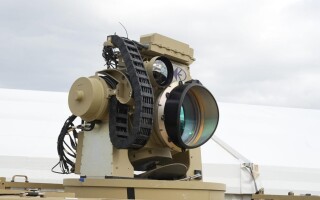Arming the latest anti-submarine aircraft with COTS multifunction displays
StoryApril 26, 2010
Modern military aircraft demand display panels that fulfill rigorous standards for flight certification and enable expansion for future requirements. This case study examines how engineers designed a military-grade display system built around a modular PC/104-Plus platform.
Boeing’s latest military derivative aircraft, the P-8A Poseidon, is a testament to the technical innovation taking place in military aircraft design. Capable of broad-area maritime and littoral operations, the P-8A will influence how the U.S. Navy’s maritime patrol and reconnaissance forces train, operate, and deploy.
Ensuring the success of the P-8A’s mission requires tracking the operation of various electrical components inside the aircraft. To help pilots with this task, test display panels are placed inside the cockpit to inform both the pilot and copilot about how these subsystems are functioning as the new platform undergoes flight qualification. Because of stringent Navy avionics requirements and various military standards, these flight display panels must be ruggedized to guarantee optimal performance.
Combining computing power and display functions
To build these cockpit display systems (shown in Figure 1), Boeing collaborated with Parvus Corporation to provide the Flight Test Display (FTD) and the Instrumentation Crew station Control Panel (ICCP) for the P-8A Poseidon aircraft. The project also involved designing a custom DVGA switch to simultaneously display the data on both of the cockpit FTDs. Boeing selected these displays because they allowed engineers to leverage existing COTS hardware that was hardened to the operational parameters expected to take place during the Poseidon’s flight testing. A Dzus rail-mount panel and set of flip-down display-mounting brackets were configured for these COTS designs.
Figure 1: The P-8A Poseidon cockpit uses test display panels from Parvus Corporation to track the operation of various electrical components inside the aircraft. (Photo courtesy of Boeing.)
Parvus engineers set about the task of developing the ICCP by combining the proven durability and power of the company’s DuraCOR mission computer with its legacy COTS Multi-Function Display (MFD). The ICCP later became the DuraVIS 4300, a new MFD for presenting flight, sensor, mapping, advisory, and other information to the crew.
Overcoming EMI roadblocks
As work began on the ICCP, engineers quickly learned that ruggedizing these displays to meet the Navy’s exacting requirements for flight certification required creative engineering. For example, the displays created some difficulties with EMI that initially prevented the system from passing certification tests. MIL-STD-461E test parameters required compliance with CE101, CE102, CS114, RS101, RS102, and RS103 requirements for conducted and radiated emissions and susceptibility across various wavelengths and frequencies. To alleviate this issue, engineers worked with a manufacturer that produced a specialized indium tin oxide material to develop a coating that would provide the right level of clarity and brightness while preventing electrons from entering or escaping the displays. The coating they developed immediately passed testing without presenting any additional EMI issues.
The end result was a robust, flight-qualified mission computer that included an integrated, sunlight-readable 6.5" LCD screen equipped with an anti-glare cover for impact protection and a high-luminance (800-nit) LED backlight for long lamp life and dimming capabilities.
Modularity ensures longevity
The unit needed to undergo rigorous MIL-STD environmental and EMI qualification testing and be based on open architecture embedded hardware. In addition, Boeing wanted the ability to add PC/104-Plus I/O boards into the subsystem’s card slots to meet future mission requirements. Consequently, options for MIL-STD-1553/ARINC 429 bus controllers, digital I/O interfaces, synchronous/asynchronous serial controllers, and video capture devices were included in the system design. A 79-pin expansion connector on the rear panel was routed to an internal breakout board and headers to support application-specific PC/104-Plus card integration without mechanical changes.
Ruggedizing to the highest standards
Because the P-8A Poseidon is a long-range intelligence, surveillance, and reconnaissance aircraft intended for anti-submarine and anti-surface warfare, the embedded designs within the aircraft had to endure extreme testing and engineering revamps to ensure the highest-quality rugged platform for the Navy. Furthermore, the aircraft presented specific ruggedization challenges, such as altitude requirements, temperature variations, vibration, and crash safety. Equipment inside the P-8A is in a pressurized environment but must survive decompression to altitudes between 30,000 and 40,000 feet.
To ensure the system’s ability to operate in a pressurized environment, engineers utilized designs and testing results from previous projects and applied this knowledge and experience to the new unit. Engineers designed each subassembly with a pressure differential per a robust set of rules, including a safety margin of 200 percent, to maintain structural integrity even in the event of a sudden change in pressure. Consequently, no issues with pressurization or rapid decompression were presented during qualification testing per MIL-STD-810F (Method 500.4, Procedure 3) from 1,500 feet below sea level to 41,000 feet above.
In addition, the unit needed to survive crash safety parameters to ensure that no portion of the display or MFD would create a hazard to personnel. All metal work, fasteners, and mechanical design considerations targeted high reliability and flight safety. Several components were bonded to the printed circuit boards. Certain cables were removed and cable lengths were restricted to eliminate wire breakage under stress. Again, the system passed qualification testing with no changes required. In fact, the unit survived the crash safety tests in a fully functional state.
Thermal management often presents a challenge for embedded designs within aircraft, as fewer air molecules are available to dissipate heat at high altitudes. At 40,000 feet, roughly one-fifth of the amount of atmospheric pressure (2.7 PSI) is available for convective or conductive cooling compared to at sea level (14.7 PSI). By physically oversizing heat sinks, performing calculations at the higher pressure differential, and conducting initial thermal evaluation tests in-house before full MIL qualification testing, engineers ensured that the system would perform well in a high-altitude environment. Test results confirmed that the system would meet the targeted -20 °C to +60 °C operating temperature range and -55 °C to +71 °C storage temperature range.
In the end, the DuraVIS 4300 (Figure 2) passed all required standards, including MIL-STD-810F, MIL-STD-704E, and MIL-STD-461E. Additionally, although destined for installation in a crew environment, the equipment was tested using the shock and vibration conditions present in other rough locations. The P-8A’s flight display systems were tested to the same shock (15 g sawtooth) and random vibration profiles (0.022 g²/10 Hz to 0.0026 g²/2,000 Hz) that would be required if they were moved to harsher environments, ensuring the highest standard of ruggedized durability. This robust system design philosophy has led to follow-on projects with single- and multi-core processors onboard the AC-130, CP-140, and P-3.
Figure 2: The Parvus DuraVIS 4300 and 3006 display systems are used inside the Boeing P-8A Poseidon aircraft.
Creating a flight display system that can withstand environmental challenges to meet the Navy’s stringent requirements while still being usable for pilots requires creative engineering to surmount difficult design parameters. Installing rugged PC/104-based systems such as the DuraVIS 4300 in a prestigious aircraft like the P-8A Poseidon provides the necessary equipment to ensure maximum interoperability in the future battle space.
Dave Turner is senior mechanical engineer at Parvus Corporation, based in Salt Lake City, Utah. He has more than 25 years of engineering experience, including development programs with all branches of the Armed Forces in areas such as B-1, B-2, F-117, F-14, A-7, F-22, space environments, missiles, ground vehicles, and shipboard equipment. Dave can be reached at [email protected].
Parvus 801-433-6348 www.parvus.com








